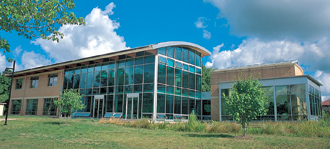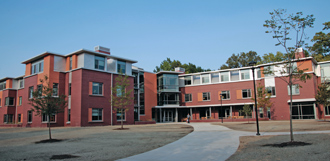Oberlin Alumni Magazine
Winter 2010-11 Vol. 106 No. 1
A Decade of Difference
Reflections on the Lewis Building
 Adam Joseph Lewis Center for Environmental Studies
Adam Joseph Lewis Center for Environmental Studies(photo by Jennifer Manna)
It was a bleak, snowy evening in December 1999 when I rolled into Oberlin to start a career as a junior faculty member in Oberlin’s Environmental Studies Program. Final touches were being made to the Adam Joseph Lewis Center for Environmental Studies, the brainchild and product of many years of dedicated work on the part of David Orr and a group of visionary thinkers, including architects, engineers, philanthropists, poets, philosophers, landscape planners, and at least two generations of Oberlin students.
A good many things have happened in the last 10 years within the program and within the college, the town, and the world. During the design of the Lewis Center, David Orr spoke of the "pedagogy of architecture"—the ways in which buildings teach lessons about human relationships with each other and with the natural environment. As it turns out, lessons learned from the Lewis Center have contributed to good things in the larger world during these last 10 years.
Within a week of moving into the building, we were initiating the self-organizing ecological processes involved in starting up the "Living Machine," John Todd’s technology that condenses and amplifies natural wetland processes to treat and then internally recycle water within the center. In many ways the alchemy involved in initiating that ecosystem—the melding of a mélange of tropical and native plants with healthy doses of microbial goo and mud harvested from our local wastewater treatment facility and Plum Creek—provides a reasonable metaphor for the way in which the Lewis Center has served as a seed and catalytic icon for the evolving field of ecological design.
Visionary Architect Returns for Lewis Center Anniversary
When a poet rose to commemorate the unveiling of an effective solar house in cloudy Ireland designed by architect William McDonough, he said simply, "This is a fierce commotion."
McDonough’s career has been a series of such commotions, and his design of the Adam Joseph Lewis Center is among the fiercest. The building was named the most important green building of the last 30 years by Architect magazine.
McDonough was on hand for the 10th anniversary of the Lewis Center in October, marked by two days of panel discussions and speeches, including his own address, in which he asked listeners to imagine a tree as a design assignment.
"Design a building that makes oxygen, that sequesters carbon, fixes nitrogen, distills water, provides habitat for hundreds of species, accrues solar energy, has food and fuel, makes complex sugars and food, creates microclimates, changes colors with the seasons, and self-replicates. How are we doing?
"It took our species 5,000 years to put wheels on our luggage," he added. "We’re not that smart."
While his talk and many of the event’s speakers sounded dire cautions about the planet’s prospects if dramatic change doesn’t occur, McDonough ended on an upbeat note.
Talking about the influence the building has had beyond Oberlin, McDonough addressed David Orr directly. "A building, like a tree, sends its seeds out," he said. "We did it, David; the building’s self-replicating."
—Jeff Hagan
Certainly there was ample intent and ambition in those who initiated the center’s design, but little could they have envisioned the particular ways in which processes would unfold and influence the lives and career trajectories of those who participated in or were simply inspired by the endeavor.
When I first accepted this faculty position, one of my good friends in the environmental community asked me, "So what do you think it’s going to be like living in the wake of David Orr?"
My somewhat glib response at the time was, "I’m hoping to get up and surf the wave." A lot of us have been riding that wave. A few of the local organizations and businesses inspired or influenced by the development of the Lewis Center include the Cleveland Green Building Coalition, founded by Sadhu Johnston ’98, who went on to lead environmental efforts for the cities of Chicago and now Vancouver; the New Agrarian Center, City Fresh, and Jones Memorial Farm, founded by Brad Masi ’93; the Black River Café and Agave restaurants, established by Joe Waltzer ’98; the Oberlin Market, created by Sarah Kotok ’98; Sustainable Community Associates and the East College Street Development, created by Naomi Sabel ’02, Josh Rosen ’01, and Ben Ezinga ’01; Full Circle Fuels, founded by Sam Merrett ’05; and Lucid Design Group, created in part by Michael Murray ’04, Vladi Shunturov ’05, and Gavin Platt ’06.
On campus, several major projects are rooted in lessons explored and embodied in the Lewis Center, such as a comprehensive, collegewide environmental policy, a unique green energy purchasing agreement, a LEED-silver building policy, a climate-neutral commitment, a Campus Resource Monitoring System, the designation of the city of Oberlin as a Clinton Climate Positive City, and initiation of the Oberlin Project—an initiative encompassing and advancing the principles of the planned green arts district.
The verdict is still out on the quality of human achievements in the 21st century. But there’s a decent chance that when the inhabitants of this planet look back, they may well see the Lewis Center and other projects now brewing in Oberlin as examples of the beginnings of what we either did or should have done in society as a whole.
A version of this article originally appeared in the spring 2010 issue of the environmental studies alumni newsletter.
Green Building 2.0: Robert Kahn Hall
 Robert Kahn Hall (photo by Jennifer Manna)
Robert Kahn Hall (photo by Jennifer Manna)
Oberlin’s newest student residence hall, Robert Kahn Hall, was formally dedicated September 25 to celebrate not only the opening of the most environmentally friendly dormitory on campus, but also the life of the man for whom it is named, the late Robert Louis Kahn ’55.
Kahn’s family found it particularly appropriate that the hall named in his honor would be dedicated to sustainability, since Kahn himself had long been interested in sustainable practices. He rode his bicycle to his investment business in a Manhattan office building as often as he could, even into his advancing years. When his company eventually insisted he was too valuable an asset to put at that kind of risk, Kahn moved to within walking distance of his office.
Each of the 150 residents of the new residence hall takes a sustainability pledge before moving in, promising not to bring a car to campus, to conserve water and energy, reduce waste, and actively seek environmentally friendly living habits.
"Students played a key role. They wanted a place where they could live and where they could create a community committed to sustainability"
Students were involved in designing programming for the dorm and the building itself, which features clotheslines in laundry rooms, an onsite compost tumbler, and an interlock system that automatically shuts off heat or air conditioning when windows are open.
"Students played a key role," said Board of Trustees Chair Robert S. Lemle during the dedication ceremony. "They wanted a place where they could live and where they could create a community committed to sustainability."
Alix Simonson ’11, one of the students involved in the building’s planning, said her initial doubt over whether the students’ ideas would be heard was short-lived. "I quickly realized that the administrative team was not only going to listen to our ideas, but was happy to let us make many of the decisions," she said. "And ideas for a multilevel zip-line and hot tubs in every room aside, my contributions and opinions were taken seriously.
"While not every idea was viable, it was obvious that creating a green dorm was a priority for all," she added. "When the idea finally arose that the students living there should embrace a green theme as well, it (also) seemed obvious."
Although no members of Kahn’s family were able to attend the dedication ceremony, several asked that their thoughts be read by President Marvin Krislov.
"It was the work ethic and the passion that I’m sure was fired at Oberlin that held Bob in good stead for the rest of his life," wrote Kahn’s wife, Helen. "It was one of the reasons he wanted to give back to the institution that gave so much to him."
Kahn, who enjoyed a long career as an investment manager in New York, died in 2009, leaving more than $34 million to Oberlin. The Robert Kahn Track, dedicated in 2008, is also named in his honor.
Remarks by Alix Simonson ’11 on the opening of Robert Kahn Hall
September 25, 2010
Thank you, Dean Gates. I am honored to speak with you today. Many people worked hard to create the building you see before you. And I was by no means the only student involved.
When I was first asked to sit on the student committee for the design of a new first year dorm I was a little dubious. Were the students there simply in a symbolic capacity? Certainly none of us had architectural experience. But I quickly realized that the administrative team was not only going to listen to our ideas, but was happy to let us make many of the decisions. And ideas for a multi-level zipline and hot tubs in every room aside, my contributions and opinions were taken seriously.
When we explained that the hallway structure of certain dorms was isolating, the architects put their heads together to find a way to create a social environment. When we agreed that windows were key to fighting winter gloom, the res ed staff welcomed the idea of having full walls of glass. And when it came down to the details, it was the students that picked the window shape, the students who insisted on soundproof practice rooms, and the students that spent half an hour debating blue carpeting versus green.
But even more important than paint color and bathroom design, students and staff alike were fully committed to the idea of sustainability. Oberlin has always been a campus where the student body has been at the forefront of environmental issues. And from solar panels, to composting, the administration has supported their students. Not only was this dorm no exception, but it was from the very start viewed as an opportunity to excel create a model for sustainable living.
In the first meeting students were assured, even before they could open their mouths to complain, that the building design and construction process were aiming to be LEED certified. We discussed low flow toilets, energy saving windows, rooftop solar panels, and rainwater runoff vegetable gardens. While not every idea was viable, it was obvious that creating a "green dorm" was a priority for all. When the idea finally arose that the students living there should embrace a "green theme" as well, it seemed obvious.
While the dorm is at last complete, its impact is just beginning. The building will serve as an inspiration for the school. It will encourage students’ commitment to the environmental movement, and will symbolize a meeting ground where students, faculty, and administrators can work together to create something great. I hope that the collaboration and mutual respect that took place on this project will continue into the future. Helping in the design process of this building is an opportunity not afforded to students at every school. I am still amazed and grateful that I was able to be a part of something so permanent and so profound. Thank you very much.
For more information https://oncampus.oberlin.edu/source/articles/2010/09/08/kahn-hall-residents-embrace-sustainable-living/
